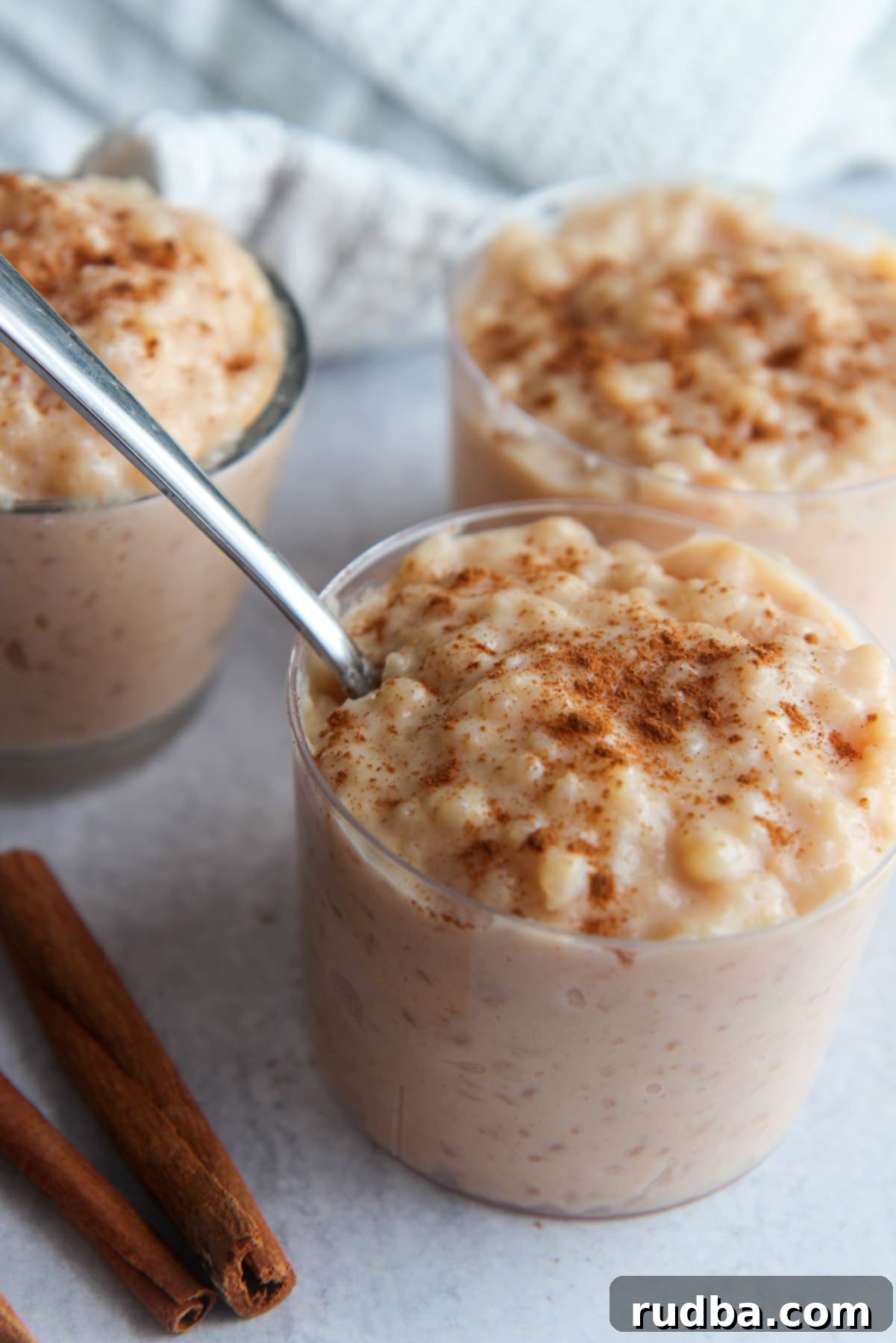Classic Rice Pudding Recipe: Your Guide to a Creamy & Comforting Old-Fashioned Dessert
There’s something uniquely comforting about a bowl of warm, creamy rice pudding. It’s a timeless dessert that evokes feelings of home and nostalgia, a simple pleasure that has delighted generations. This Classic Rice Pudding recipe embodies everything you love about this old-fashioned treat: a rich, velvety texture, the subtle warmth of cinnamon, and the sweet embrace of vanilla. It’s incredibly easy to make, requiring just a few staple ingredients and minimal effort for a truly delicious reward.
In a world of ever-changing culinary trends, homemade rice pudding remains a steadfast favorite. Its enduring appeal lies in its simplicity and the heartwarming satisfaction it delivers. Whether served warm or chilled, as a light dessert or a comforting snack, this easy rice pudding recipe promises to be a hit with your entire family. Forget complex ingredients or fancy techniques; this recipe focuses on pure, unadulterated flavor and a wonderfully creamy consistency that will have everyone asking for seconds.
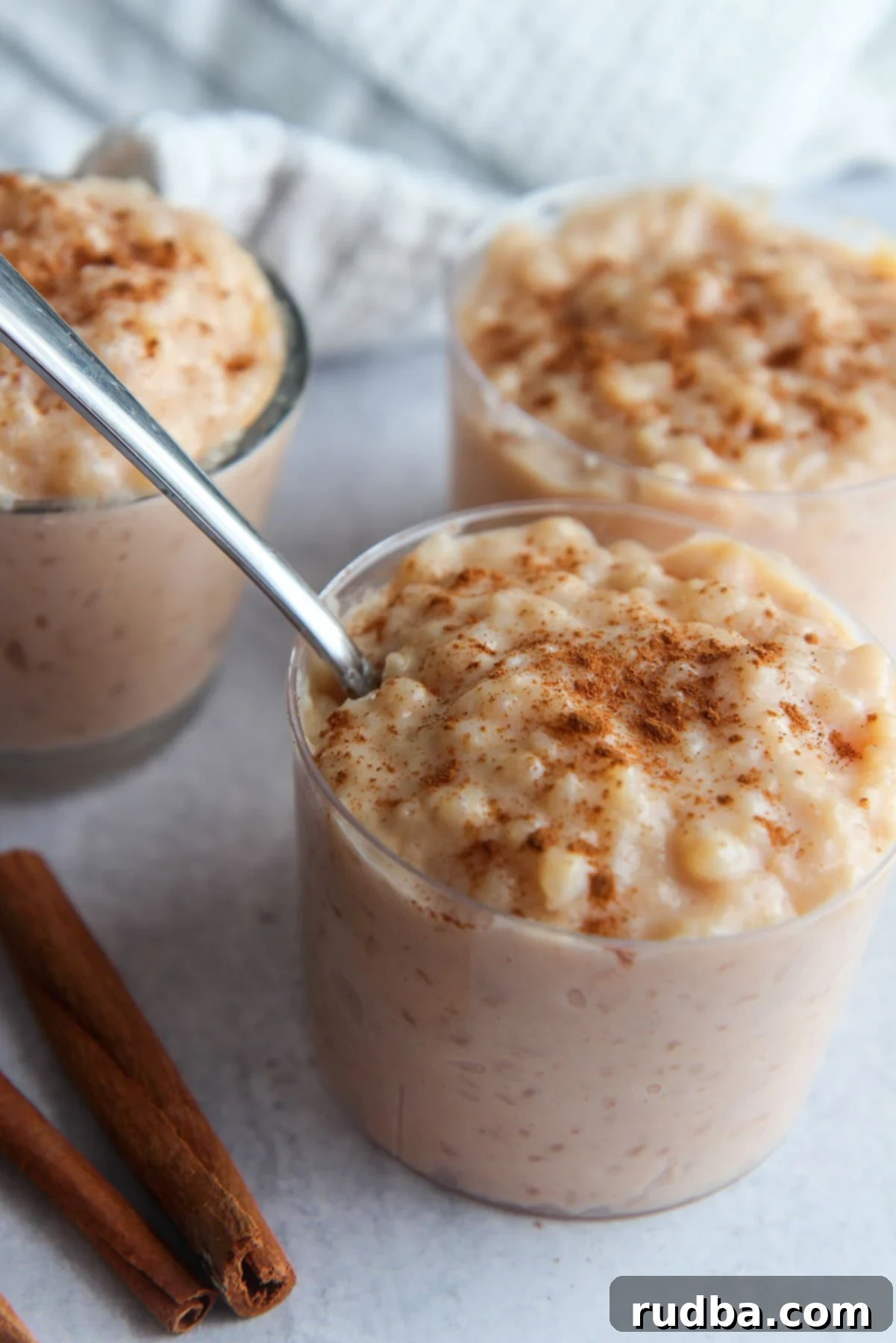
The Enduring Charm of Homemade Rice Pudding
At its heart, classic rice pudding is a celebration of simple ingredients: rice, milk, and a touch of sweetness. While variations abound globally, the essence remains the same – a soothing, creamy dessert that transcends cultural boundaries. Our traditional rice pudding version focuses on pure ingredients to achieve that perfect, comforting balance. We opt for whole milk for its richness and long-grain white rice for a tender, yet distinct texture that perfectly absorbs all the delicious flavors.
Unlike some recipes that might call for sweetened condensed milk to achieve creaminess, this old-fashioned rice pudding approach relies on slow simmering, allowing the rice to release its starches and naturally thicken the milk. This method not only keeps the recipe incredibly straightforward but also results in a pudding with a more authentic, less overly sweet profile. However, if you’re a fan of sweetened condensed milk, you might enjoy this Instant Pot Arroz con Leche recipe from Julie Maestre, which offers a delightful twist on the traditional.
The beauty of this classic rice pudding recipe lies in its adaptability. While we provide the foundational “classic” version, we’ll also explore numerous ways to customize it to your liking, from adding different spices and extracts to incorporating fresh fruits or decadent toppings. But first, let’s master the basics to create a batch of creamy rice pudding that’s truly unforgettable.
Essential Ingredients for the Perfect Rice Pudding
Creating a truly delicious rice pudding begins with understanding the role of each ingredient. Quality matters here, as the simplicity of the dish means every component shines through.
- Long Grain Rice: We recommend long-grain white rice for this recipe. Its distinct grains hold their shape well while still becoming wonderfully tender and absorbing the milky goodness. Avoid instant rice, which won’t achieve the desired creamy texture. You could experiment with medium-grain or short-grain rice like Arborio (often used for risotto) for an even creamier, starchier result, but adjust cooking times accordingly.
- Whole Milk: This is the secret to a rich, luscious, and truly creamy rice pudding. The higher fat content of whole milk prevents it from curdling easily during the long simmering process and contributes significantly to the dessert’s velvety mouthfeel. While you can use lower-fat milk, it may result in a thinner pudding with less depth of flavor. For an even richer pudding, consider a splash of heavy cream at the end or substituting some of the whole milk with evaporated milk.
- Granulated Sugar: The sweetener of choice for its clean, classic taste. It dissolves easily and provides the perfect amount of sweetness without overpowering the subtle flavors of rice and milk. Feel free to adjust the amount to your personal preference. Brown sugar can also be used for a deeper, caramel-like note, but start with slightly less as its sweetness can be more intense.
- Cinnamon Stick & Ground Cinnamon: Using a cinnamon stick during the simmering process infuses the milk with a gentle, aromatic warmth that is more nuanced than ground cinnamon alone. The ground cinnamon is then stirred in at the end for a bolder, more immediate flavor, and often used as a beautiful garnish. This two-pronged approach ensures a wonderfully layered cinnamon presence in your sweet rice dessert.
- Vanilla Extract: A true essential for any classic dessert. Pure vanilla extract adds a comforting, sweet aroma and flavor that perfectly complements the cinnamon and milk. Add it at the end to preserve its delicate notes, as prolonged cooking can diminish its potency.
- Salt: Just a pinch of salt might seem counterintuitive in a sweet dish, but it’s crucial. It enhances all the other flavors, balancing the sweetness and making the vanilla and cinnamon sing. Don’t skip it!
How To Make Classic Rice Pudding: A Step-by-Step Guide
Making this classic rice pudding is simpler than you might think. The key is patience and gentle simmering to achieve that perfect creamy consistency.
- Combine Ingredients: In a medium to large heavy-bottomed saucepan, combine the long-grain rice, whole milk, granulated sugar, one cinnamon stick, and salt. A heavy-bottomed pan is essential to prevent scorching and ensure even heat distribution during the long cooking process. Give everything a good stir to combine all the ingredients thoroughly and dissolve the sugar.
- Gentle Simmering: Place the saucepan over medium-high heat initially, bringing the mixture to a gentle boil. Once it starts boiling, immediately reduce the heat to low, ensuring it maintains a steady, gentle simmer. This is crucial for preventing the milk from boiling over and for allowing the rice to cook slowly and absorb the liquid. Stir frequently, every 5-10 minutes, especially during the latter half of cooking, to prevent the rice from sticking to the bottom of the pan and to encourage uniform thickening.
- Cook to Perfection: Let the mixture simmer for about 1 hour. The cooking time can vary slightly depending on your stove and the type of rice, so pay attention to the consistency. You’ll know it’s ready when the rice is tender, and the mixture has thickened to a consistency similar to yogurt or a thick custard. It should be creamy and rich, but still pourable. Remember, it will continue to thicken as it cools.
- Remove from Heat & Flavor: Once the desired consistency is reached, remove the saucepan from the heat. Immediately stir in the ground cinnamon and vanilla extract. The residual heat will help these flavors meld beautifully into the warm pudding. Taste and adjust sweetness if desired. Remove the cinnamon stick.
- Cool and Chill: Allow the rice pudding to cool down to room temperature on your countertop. This step is important for preventing condensation if you plan to cover and refrigerate it. Once it’s cooled, cover the saucepan or transfer the pudding to an airtight container and place it in the fridge to chill thoroughly. Chilling for at least 2-3 hours, or even overnight, allows the flavors to deepen and the pudding to set into a wonderfully creamy texture.
- Serve and Enjoy: Once perfectly chilled, give the pudding a final stir. Spoon it into individual serving bowls. For an extra touch of flavor and visual appeal, garnish with a light sprinkle of ground cinnamon, a fresh cinnamon stick, or any of the delightful toppings we suggest below. Serve and savor this timeless classic!
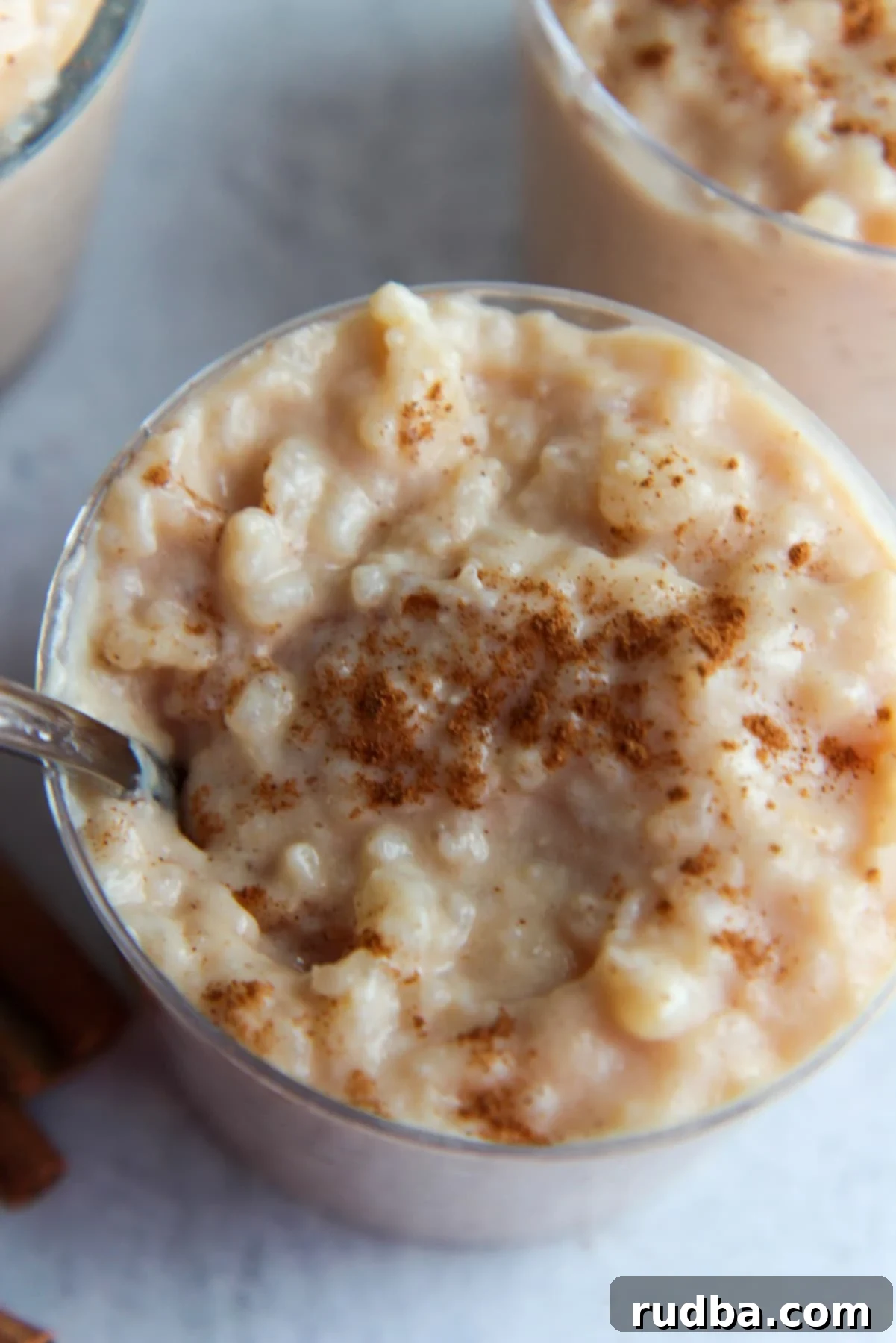
Tips and Variations for Your Perfect Rice Pudding
While the classic rice pudding recipe is fantastic on its own, here are some tips and ideas to customize your dessert and make it truly your own:
- Explore More Spices: Beyond cinnamon, a world of warm spices awaits. Consider adding a pinch of ground nutmeg or ginger for an extra layer of warmth. Cardamom pods, star anise, or even a tiny amount of cloves can lend an exotic, fragrant touch. Add these during the simmering phase with the cinnamon stick.
- Experiment with Extract Flavors: Vanilla is a classic, but don’t hesitate to venture out! Almond extract offers a delightful nutty note, while coconut extract can transport you to a tropical paradise. Lemon or orange zest (added during simmering) or a few drops of their respective extracts can provide a bright, citrusy counterpoint. Even a touch of rum or maple extract can create an interesting depth of flavor. Always add extracts after removing from heat to preserve their aroma.
- Serve it Your Way – Warm or Chilled: Rice pudding is incredibly versatile in its serving temperature. Many prefer it chilled, where its creamy texture and flavors are beautifully set. However, a bowl of warm, freshly made rice pudding is pure comfort on a cold day. Try both ways to discover your personal preference! If reheating, do so gently on the stovetop or in the microwave, adding a splash of milk if it’s too thick.
- Incorporate Fresh or Dried Fruit: Fruits add natural sweetness, texture, and a burst of flavor. Stir in raisins, cranberries, or chopped dates during the last 15-20 minutes of simmering so they can plump up. For fresh fruits, such as berries, sliced peaches, or mango, add them just before serving. For inspiration, check out Julie’s Rice Pudding with Peaches recipe!
- Delicious Toppings: Elevate your rice pudding with simple yet effective toppings. A dollop of fresh whipped cream is an all-time favorite, adding a light, airy contrast to the rich pudding. Other ideas include toasted nuts (almonds, pecans, walnuts), a drizzle of caramel or chocolate sauce, a spoonful of fruit compote or jam, a sprinkle of toasted coconut flakes, or a handful of fresh berries.
- Different Rice Varieties: While long-grain is recommended for this classic recipe, short-grain rice (like Arborio or Calrose) will yield an even creamier, stickier pudding due to its higher starch content. Brown rice can be used for a nuttier flavor and chewier texture, but will require longer cooking time and potentially more liquid.
- Milk Alternatives: For dietary reasons or flavor preferences, you can substitute some or all of the whole milk. Almond milk, oat milk, or coconut milk (for a distinct tropical flavor) can work, but note that the final texture and richness will differ. You might need to add a bit of cornstarch slurry at the end if it doesn’t thicken enough, or consider using full-fat coconut milk for more body.
Top Tip for Ultimate Indulgence:
For an absolutely divine experience, always serve your Classic Rice Pudding with a generous swirl of fresh, homemade whipped cream. The light, airy texture and delicate sweetness of the cream create the perfect counterpoint to the rich, creamy pudding, making every spoonful an indulgence.
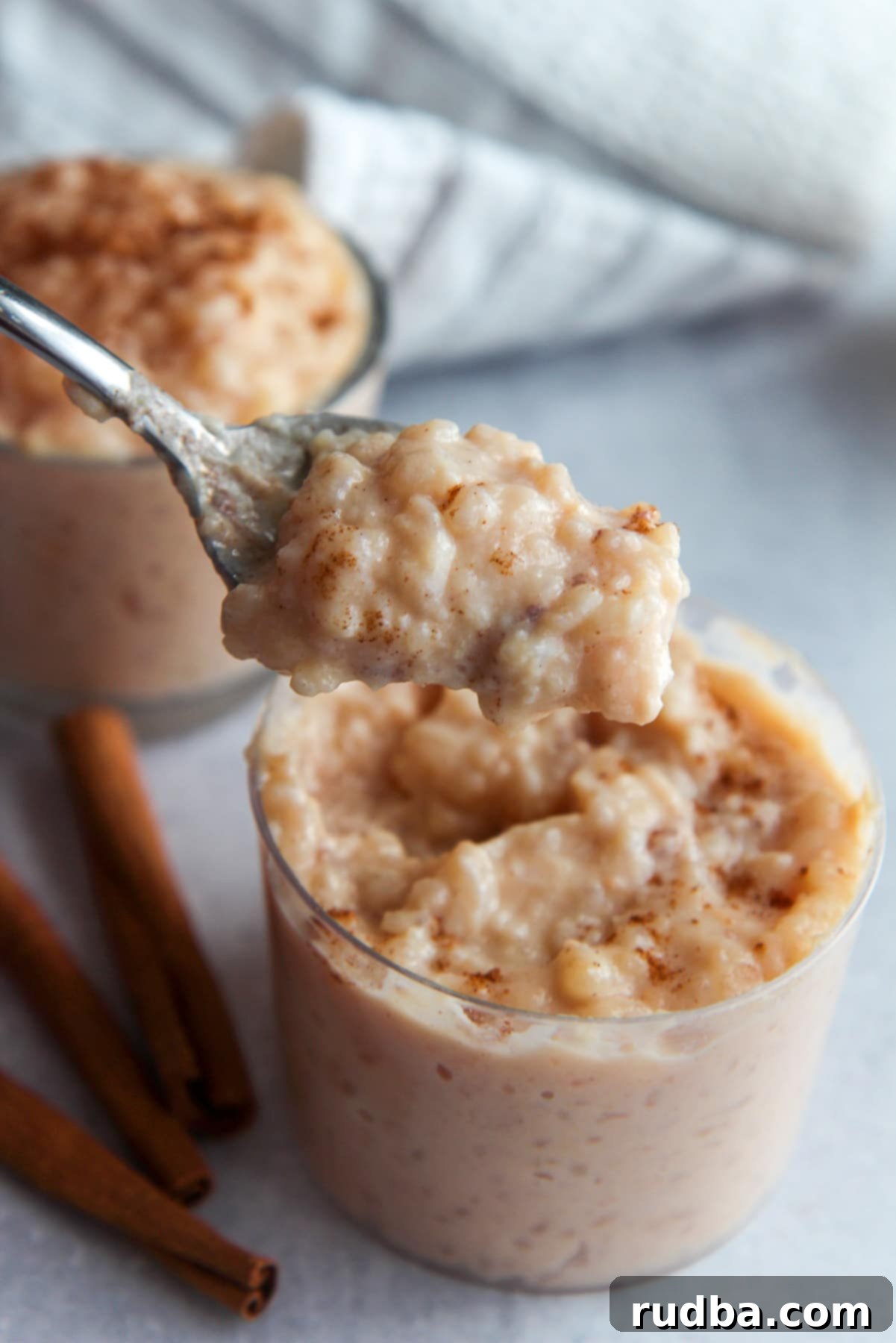
Why is Rice Pudding Classified as a Pudding? Understanding the Culinary Term
The term “pudding” carries a fascinating history, evolving significantly over centuries. Originally, in medieval Britain, “pudding” (derived from the Old French “boudin,” meaning small sausage) referred to a dish, often savory, made by enclosing various ingredients (typically meat, suet, or grain) in an animal’s stomach or intestine, much like a sausage. The word they used was often “poding.”
Over time, the meaning broadened. By the 17th and 18th centuries, it began to encompass a wider range of cooked dishes, both savory and sweet, often steamed or boiled in a cloth bag or basin. Sweet puddings started gaining popularity, particularly those made with grains, flour, or bread. Rice pudding, with its simple ingredients cooked together to form a cohesive, soft dish, fit this evolving definition perfectly.
In modern North American usage (primarily in the United States and Canada), “pudding” has largely become synonymous with a specific type of dessert: a creamy, milk-based confection with a thick, custard-like consistency, often thickened with starch (like cornstarch) or, in the case of rice pudding, with the starches from the rice itself. The original “poding” pronunciation evolved into the more familiar “pudding” over many years.
Interestingly, in British English, “pudding” still retains a broader meaning. It can refer to any dessert course after a main meal (e.g., “What’s for pudding?”). This is why traditional British dishes like “Yorkshire pudding” (a savory batter dish) or “Christmas pudding” (a dense, fruit-filled steamed cake) are still called puddings, even though they bear little resemblance to the creamy, milk-based desserts Americans typically associate with the term. However, the British also use “pudding” to refer to creamy desserts, making it a more inclusive term than its North American counterpart.
So, rice pudding is classified as a pudding because it fits both the historical and modern definitions of a sweet, cooked, cohesive dish, particularly one that is creamy and often milk-based.
A Little Rice Pudding History: From Ancient Grains to Global Delight
The history of rice pudding is as rich and comforting as the dish itself, stretching back not just centuries, but millennia. While its exact origin point is debated among food historians, there’s a strong consensus that this beloved dessert likely originated in either India or China.
- Ancient Roots in Asia: Both India and China boast incredibly deep and ancient rice cultures, where rice has been a staple crop for thousands of years. It’s only natural that early civilizations in these regions would experiment with rice in various culinary forms, including sweet preparations. Many historians lean towards India as the more probable birthplace, primarily because India also has an ancient and extensive sugar culture. The combination of rice and sugar to create a sweet, milky dish would have been a natural evolution. Early versions were often more medicinal, prescribed for stomach ailments, or served as an energy-rich food.
- Spread to the Middle East and Europe: From its Asian origins, rice pudding began its journey westward. It traveled along ancient trade routes, reaching the Middle East and then Europe. In medieval Europe, rice was a luxury ingredient, often imported and expensive, making rice pudding a dish primarily enjoyed by the wealthy or reserved for special occasions. Early European recipes, dating back to the 13th and 14th centuries, often called for rice to be cooked in almond milk (since cow’s milk was less commonly consumed by adults or for religious reasons during Lent) and sweetened with honey or sugar. These early versions were sometimes baked in pastry or served as a side dish to savory meals.
- Evolution into a Comfort Food: As sugar became more accessible and dairy farming more widespread, rice pudding transitioned from a luxury item to a more common household staple. Each culture adapted the basic recipe to its local ingredients and tastes. For example, in Scandinavia, it’s a Christmas tradition, often with an almond hidden inside for good luck. In Latin America, “arroz con leche” often features citrus zest and condensed milk. In the UK, it became a beloved nursery food, often baked slowly in an oven.
Today, rice pudding remains a global culinary phenomenon, celebrated in countless variations, each reflecting the unique heritage of its region. Yet, at its core, it always returns to that simple, comforting blend of rice, milk, and sweetness that has brought joy for centuries.
More Delicious Dessert Recipes You’ll Love:
If you’ve enjoyed making this classic rice pudding, you might be looking for more sweet treats to try. Here are some other delightful dessert recipes from Julie that are sure to please:
- Coconut Flan – A rich and creamy tropical twist on a classic flan.
- Apple Fritters – Crispy, sweet, and bursting with apple flavor, perfect for a cozy morning.
- No-Bake Mini Nutella Cheesecake – Indulgent and incredibly easy, these mini cheesecakes are a chocolate lover’s dream.
- Coconut Tres Leches Cake – A moist and tender cake soaked in three kinds of milk, with a tropical coconut essence.
- White Chocolate Tarts – Elegant and decadent, these tarts are a showstopper with their creamy white chocolate filling.
For more culinary inspiration and helpful cooking tutorial videos, be sure to subscribe to Julie’s channels on YouTube and Facebook. You’ll find a wealth of recipes designed to make home cooking enjoyable and delicious!
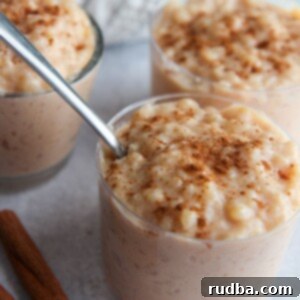
Classic Rice Pudding
Save RecipeSaved Recipe
Pin Recipe
Rate Recipe
Print Recipe
Equipment
-
saucepan (medium to large, heavy-bottomed)
Ingredients
- 1/2 cup long grain rice (uncooked)
- 6 cups whole milk
- 1 cinnamon stick
- 1/2 cup granulated sugar
- 1/4 tsp ground cinnamon
- 1/2 tsp salt
- 2 tsp vanilla extract
Instructions
-
In a medium to large heavy-bottomed saucepan, combine the whole milk, uncooked long grain rice, granulated sugar, one cinnamon stick, and salt. Stir gently to ensure all ingredients are well-mixed.
-
Place the saucepan over medium-high heat and bring the mixture to a gentle boil. As soon as it begins to boil, reduce the heat to low, ensuring the mixture maintains a steady, gentle simmer.
-
Continue to simmer for about 1 hour, stirring frequently (every 5-10 minutes) to prevent sticking and ensure even cooking. Cook until the rice is tender and the mixture has thickened to a rich, creamy consistency, similar to a thick yogurt or custard. It will thicken further as it cools. Remove the cinnamon stick.
-
Remove the saucepan from the heat and immediately stir in the ground cinnamon and vanilla extract. This ensures their vibrant flavors and aromas are preserved.
-
Allow the rice pudding to cool to room temperature before covering it and placing it in the refrigerator to chill thoroughly for at least 2-3 hours, or ideally overnight, for best flavor and texture.
-
Serve chilled, garnished with an additional sprinkle of ground cinnamon or a dollop of fresh whipped cream, if desired. Enjoy your homemade classic rice pudding!
Nutrition
Nutrition information is automatically calculated, so should only be used as an approximation.
Additional Info
Like this recipe? Leave a comment below!
